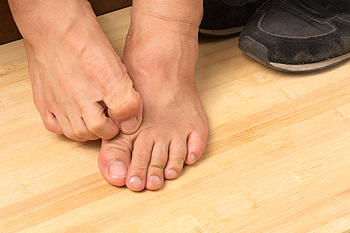 If your toes start to itch and tiny blisters begin to form between them, you probably have come in contact with tinea fungus, more commonly known as athlete’s foot. It thrives in warm, moist and airless conditions, such as those found in locker rooms, public showers and swimming pools. It is a good idea to avoid sharing towels, wear foot coverings in places where the fungus is likely to grow, keep from scratching the infected area, and wear absorbent socks. Although this fungus can spread easily to other parts of your body as well as to other people, it is not serious in and of itself. Many topical antifungal creams and sprays are available to treat athlete’s foot. However, if you start to feel pain, or if your foot becomes hot and red, it could be an indication of a more serious problem. Similarly, if you are diabetic or suffer from a weakened immune system, it is probably wise to consult a podiatrist to see if other treatment options are available to you.
If your toes start to itch and tiny blisters begin to form between them, you probably have come in contact with tinea fungus, more commonly known as athlete’s foot. It thrives in warm, moist and airless conditions, such as those found in locker rooms, public showers and swimming pools. It is a good idea to avoid sharing towels, wear foot coverings in places where the fungus is likely to grow, keep from scratching the infected area, and wear absorbent socks. Although this fungus can spread easily to other parts of your body as well as to other people, it is not serious in and of itself. Many topical antifungal creams and sprays are available to treat athlete’s foot. However, if you start to feel pain, or if your foot becomes hot and red, it could be an indication of a more serious problem. Similarly, if you are diabetic or suffer from a weakened immune system, it is probably wise to consult a podiatrist to see if other treatment options are available to you.
Athlete’s foot is an inconvenient condition that can be easily reduced with the proper treatment. If you have any concerns about your feet and ankles, contact Dr. Kenneth Donovan from Advanced Care Foot and Ankle. Our doctor will treat your foot and ankle needs.
Athlete’s Foot: The Sole Story
Athlete's foot, also known as tinea pedis, can be an extremely contagious foot infection. It is commonly contracted in public changing areas and bathrooms, dormitory style living quarters, around locker rooms and public swimming pools, or anywhere your feet often come into contact with other people.
Solutions to Combat Athlete’s Foot
- Hydrate your feet by using lotion
- Exfoliate
- Buff off nails
- Use of anti-fungal products
- Examine your feet and visit your doctor if any suspicious blisters or cuts develop
Athlete’s foot can cause many irritating symptoms such as dry and flaking skin, itching, and redness. Some more severe symptoms can include bleeding and cracked skin, intense itching and burning, and even pain when walking. In the worst cases, Athlete’s foot can cause blistering as well. Speak to your podiatrist for a better understanding of the different causes of Athlete’s foot, as well as help in determining which treatment options are best for you.
If you have any questions please feel free to contact one of our offices located in Warren, Livingston, and Toms River, NJ . We offer the newest diagnostic and treatment technologies for all your foot and ankle needs.

